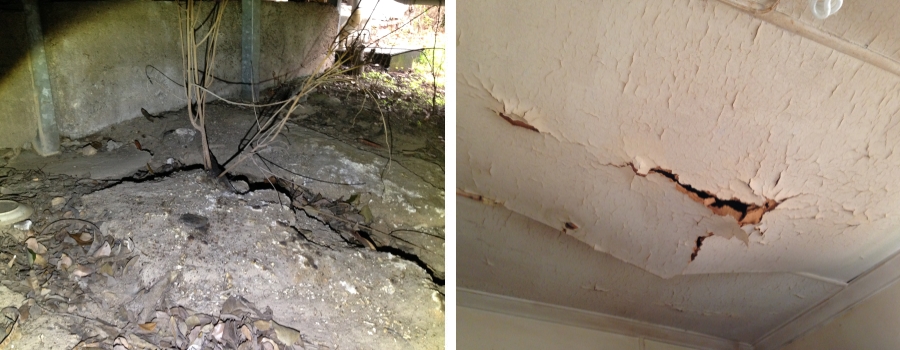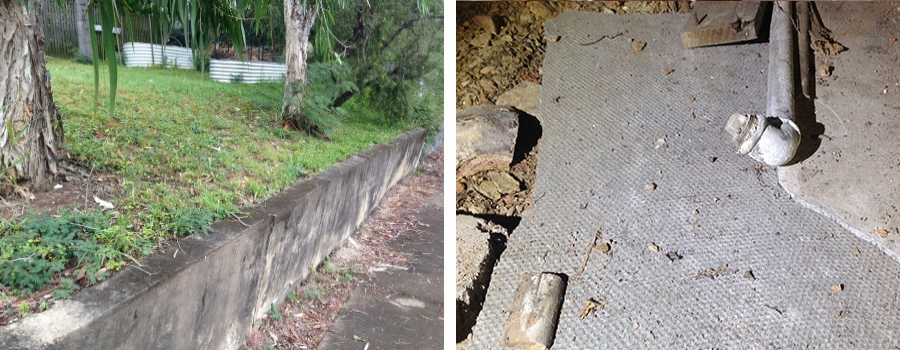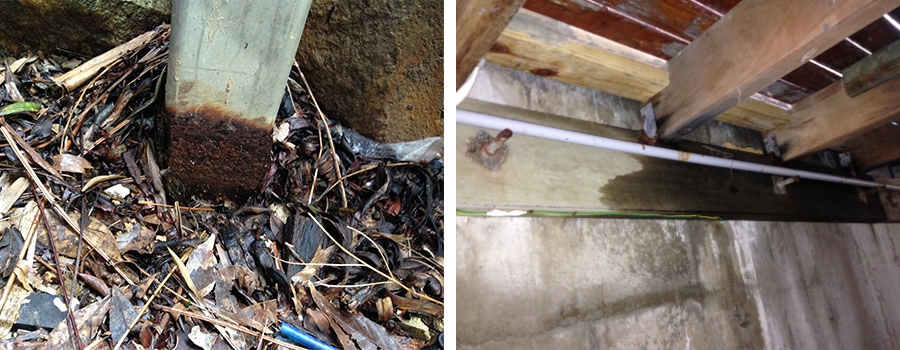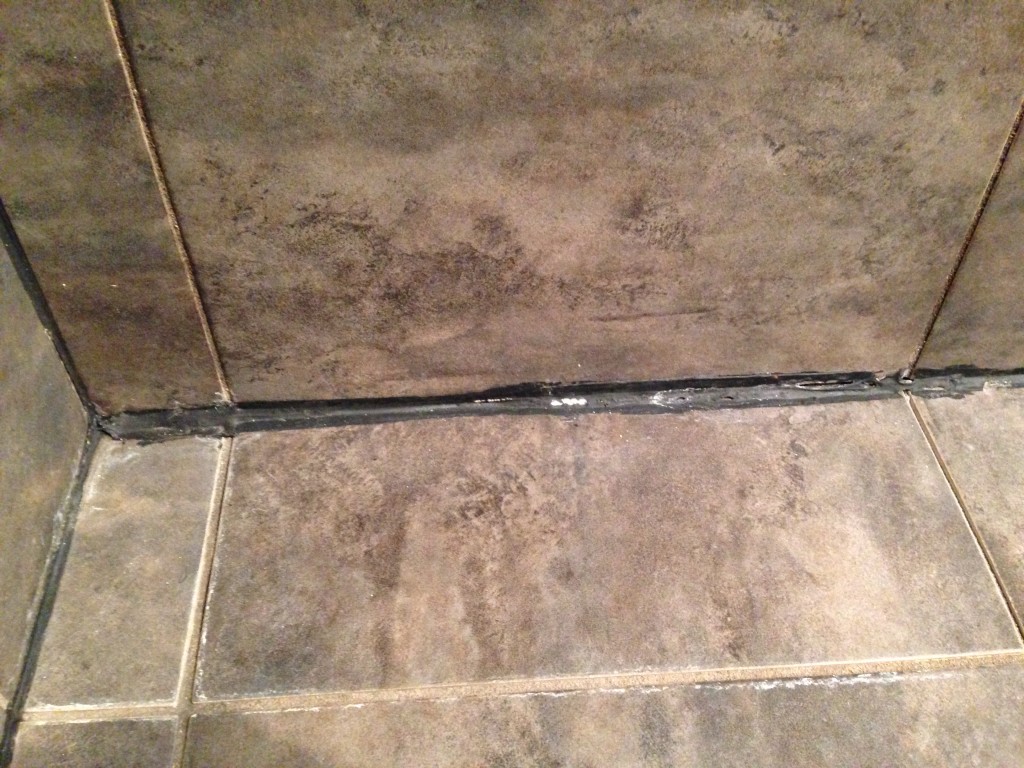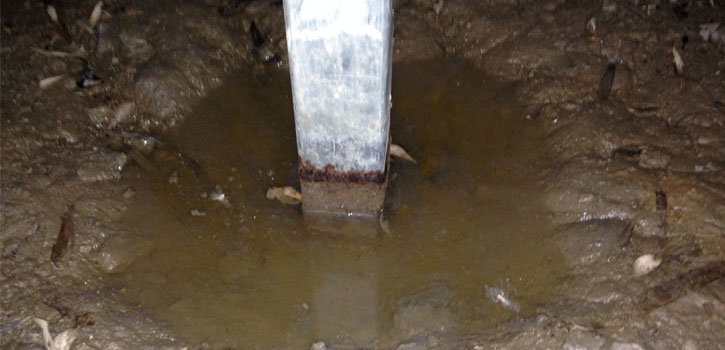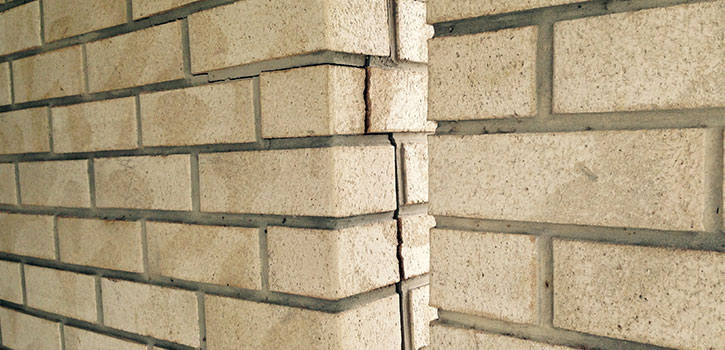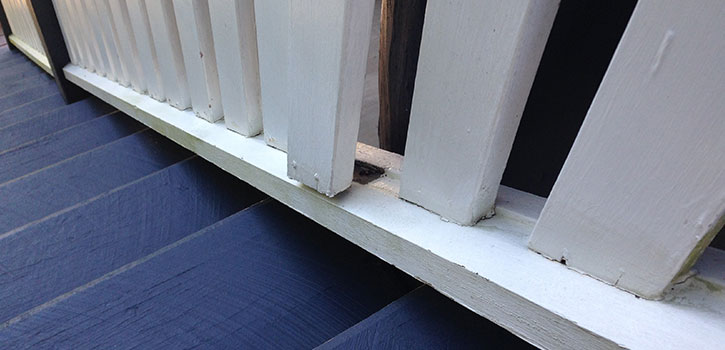Exterior Areas
The areas listed below have been identified over the years from research and experience and while designed to assist property owners with their termite management, the following list may not be altogether conclusive and some items of course may not apply to all properties.
- Tree Stumps. Tree stumps are a perfect environment for the termites to create nest sites and if there are any tree stumps on the block you should have them checked by an appropriately licensed and qualified termite technician (this is normally done by drilling the tree stump). This should be done on a regular basis and certainly no longer than a two-year duration between each check. Where a hollow stump is identified, or active termite activity, then the stump should be appropriately treated in accordance with the Australian standard for termite management to eliminate the current activity and to impede future attraction to the stump. You should also try to obtain access to adjacent and neighbouring blocks and ensure they too have any stumps treated in the same manner as termites can forage for between 50-100 meters, subject to the colony size and genus.
- Loose Timbers in Block. Any fallen tree branches, wood stacks, stacked firewood, logs or timber matter within the block. Any heavily or over vegetated garden areas.
- Mature Trees. Mature trees, particularly those of the eucalyptus variety, are known to be a favoured location for termites and their nest sites and any trees within the 50 to 100 m range of the structure should be checked regularly by way of drilling at its base. Any hollow spots when drilling into the tree would indicate the probability of termites being present is normally this would be solid. Obviously where it is detected that there are drill holes which may have a hollow feeling when being drilled been the injection of termiticide into this area should be carried out by an appropriately licensed termite technician.
- Ground against structure Any ground/garden beds, against building lines, including adjoining timber structures like fences which can provide an opportunity for termites to bridge into the structure. These risks can be increased where the ground is concealing weepholes and is excessively watered.
- Where there are higher exterior ground levels than internal floor levels there is an opportunity for any termites to gain access into the structure in a concealed manner via the higher exterior ground. It also creates an opportunity for moisture permeation in the event of a drainage failure and it is preferable and far more desirable to have no ground abutting the structure higher than the internal floor.
- Any filled slabs a e.g. patios and balconies abutting the perimeter of the building.
- Retained Ground Moisture. One of the biggest attractions to termites is the presence of moisture, either retained in the ground or within the structure wall and floor cavities, and it must be avoided at all times. Some factors contributing to retained ground moisture being present are:
- Land contours sloping toward subject residence.
- Excessive watering of vegetation near the structure.
- Inadequate drainage, in some cases indicative of ponding water.
- Rusting gutters/downpipes
- Leaking gutter/downpipe joins
- Leaking hot water cylinder cylinders and pipes for the cylinder
- Damaged downpipes, mostly the PVC connections at the base
- Overflow/relief valve for hot water cylinder not being plumbed to a drainage outlet.
- Overflow for rainwater tank not connected to a drainage outlet and pipe joins for the tanks leaking
- Air conditioning pipes not being connected to drainage outlets.
- No gutters and/or downpipes in place.
- Downpipes not connected to drainage outlet or not continuously connected to the drainage outlet allowing for spillage near the building line.
- Moisture damaged materials being identified e.g. efflorescence on masonry walls, paint peeling and moisture affected materials/timbers.
You should regularly inspect all areas of your property for any signs of moisture and we detected have it immediately attended to if it is detected then appropriate rectification should be immediately carried out.
- Previously treated but subsequently disturbed ground. Where chemical Treated Zones have been installed it is essential for the effectiveness of the treatment to ensure that it is not breached or disturbed in any way for the entire duration of the life span for the treatment. Any digging, excessive moisture exposure and generally anything that could cause a disturbance to the Treated Zone should be avoided at all times, as should the placing of any materials or furniture/storage items against the structure, as this would provide a bridging opportunity for termites to bypass the treated soil and gain access to the structure. A very common issue with modern construction and in the case of exposed slab edge is being used for the exterior perimeter protection of property, is that the slab is concealed in many areas by fixed materials such as rainwater tanks, air-conditioning condenser units, hot water cylinders, metal sheds and other general loose materials. This severely compromises its intended function as a visual inspection zone for any subterranean termite activity and must be avoided at all times.
- Concealed subterranean service pipes. Often there are many service pipes and other materials, relating to drainage, plumbing, gas piping, electrical and data/Internet communications, which penetrate the structure and often times this is in a manner which is subterranean and visually inaccessible. These two factors provide a perfect opportunity for concealed termite entry into a structure, especially for slab on ground properties.
- Wood in contact with ground/masonry. Any wood/timbers in direct or indirect contact with the ground. Examples would be timber retaining walls, garden steps, landscaping timbers, sheds, pergolas, walkways, posts, poles, foundation stumps, fencing and fence posts (especially where weathered and decaying), timber wall framing and exterior cladding directly or indirectly onto slabs/foundations/nib walls without effective ant-capping. In the case of structures e.g. decks the National Construction Code requires that there be a minimum clearance between the underside of the timber and ground level of at least 400 mm to allow for ventilation of the timber is so it doesn’t deteriorate and also minimise the threat of termite entry into the structure. This is allowed to decrease to 150 mm only with is a sloping block. No ground should come into contact with timbers in any area of the block or exterior building line and where this is the case immediate corrective action should be taken.
- Slab on Ground Structures. These kinds of residential properties, often referred to as low set or slab on ground, are more prone to termite intrusions, as the construction style of it being built on the ground offers a perfect platform for any foraging termites to gain concealed termite entry into the structure, especially where there are no termite control measures in place. These kinds of properties should always have a chemical Treated Zone or Physical Termite Control Measure in place, AT ALL TIMES, around the entire exterior perimeter and any other area deemed necessary to ensure the best and most optimum termite controls are in place for the structure.
- Concealed weepholes. Concealed weepholes either by ground or masonry path type abutments are a known entry point for termites into the structure in a concealed manner. Often weepholes when houses have brick exteriors are rendered can also be concealed by the render material. Weepholes are designed to divert any moisture from the cavity of structure out of the structure and to allow for ventilation. They provide very important functions to the structure and need to be in place and there should be a minimum distance of around 75 mm from the bottom of a weepholes to the ground level beneath which allows for a visual inspection zone and a clearance to eliminate any chances of concealed termite entry into the structure. If there are any examples of the above present at subject residence and subsequently concealing weepholes, you should immediately carry out rectification to ensure that all weep holes are clearly visible and the minimum 75 mm is in place at the base.
- Inadequate Ant Capping. For residential construction from the turn of the 20th century up until the early 2000’s ant capping was one of the predominant forms and heavily relied on termite controls. Obviously being metal it will corrode and deteriorate and subject to the level of exposure to the elements, the rate of corrosion will be rapid. Most houses we inspect, unless of course they are contemporary and new, have inadequate ant capping in place as a result of the following: it is badly corroded, it is incomplete, it is entirely missing in some areas, it is not aligned correctly at 45° and it has been fitted in a manner which will not impede any termite entrance into the structure.
- Inadequate ventilation for some structures. Termites are known to favour areas that provide damp conditions and those which offer a lack of ventilation for any timbers with inadequate space allowing for crossflow of the air. All timbers and service should have a minimum of 400 mm clearance between the lowest point in the structure and ground level.
- Adjoining Structures. On some occasions residential structures will be attached directly to others, and this normally relates to townhouse and unit construction but not exclusive to some houses can also be attached. Where this occurs and there is any area of the structure is in direct contact with each other, this provides an environment for possible concealed termite entry between the two properties and is a known termite risk factor. For all cases where properties are joined with any other, it is imperative that every adjoining property within the structure has termite controls in place around its entire exterior perimeter by way of a Treated zone or Physical Termite Control Measure. In relation to structures that contain several adjoining properties, if any of the individual properties do not have termite controls in place, and ensure that they are continuously maintained, then all others within the structure are at risk of sustaining termite attack, even if they themselves have adequate and current termite controls in place.
White ants forage in the ground all over the region looking for food and are not territorial. They emerge and return to ground seeking their food source. If any of the items listed above apply to this property, present or future, then the chances of discovering white ants at some stage should not be regarded as unusual.
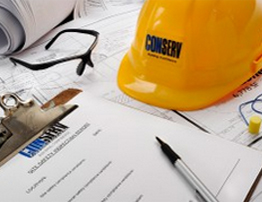


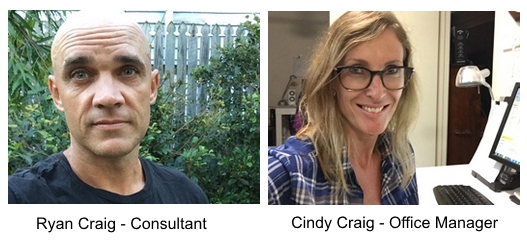
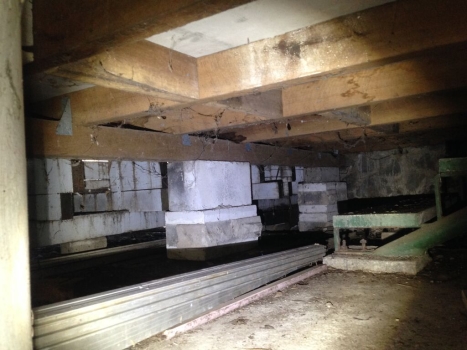
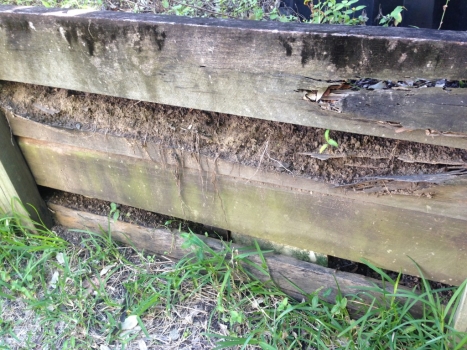
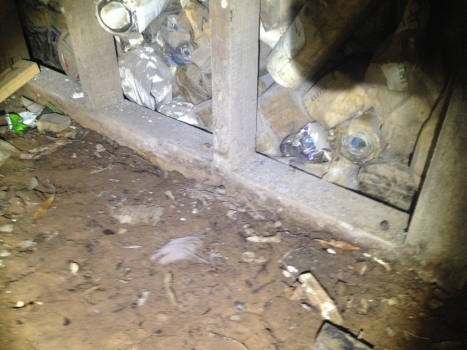
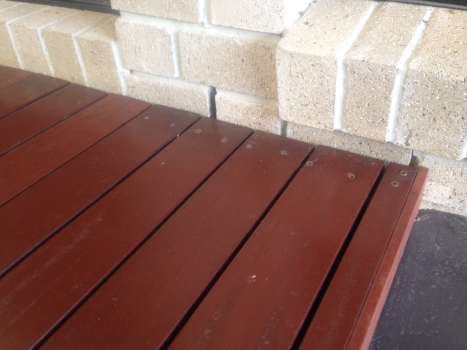
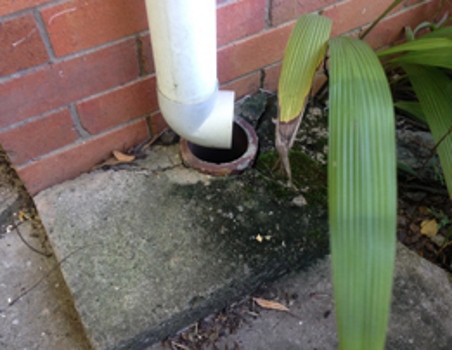 All too often during our inspections we identify areas which are conducive to the collection of retained ground moisture near a structure. Elevated moisture levels are known to provide conditions favourable to Timber Pest activity, particularly termites, and it is vital that every effort be made to avoid these risks. The most common causes of retained ground moisture are inadequate surface water drainage, downpipes not connected to drainage outlets, no gutters in place for roofing areas, outlet pipes for air conditioners, relief and overflow valves for hot water cylinders, corroding and join leakages of gutters and downpipes, defective or incomplete flashing and plumbing for rainwater tanks leaking. These are all issues which can be, and should be rectified, if they are in existence at a property.
All too often during our inspections we identify areas which are conducive to the collection of retained ground moisture near a structure. Elevated moisture levels are known to provide conditions favourable to Timber Pest activity, particularly termites, and it is vital that every effort be made to avoid these risks. The most common causes of retained ground moisture are inadequate surface water drainage, downpipes not connected to drainage outlets, no gutters in place for roofing areas, outlet pipes for air conditioners, relief and overflow valves for hot water cylinders, corroding and join leakages of gutters and downpipes, defective or incomplete flashing and plumbing for rainwater tanks leaking. These are all issues which can be, and should be rectified, if they are in existence at a property.
